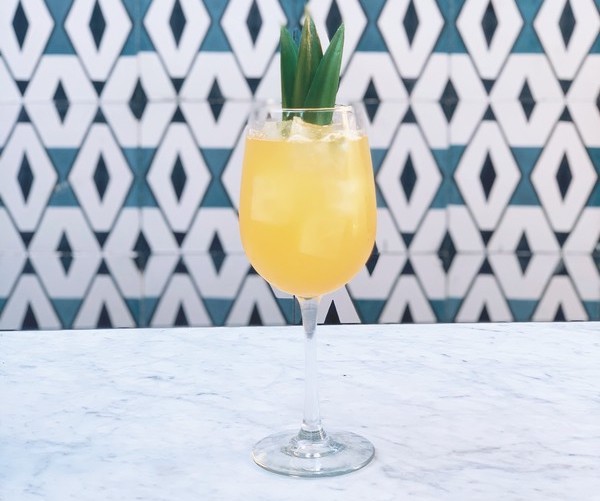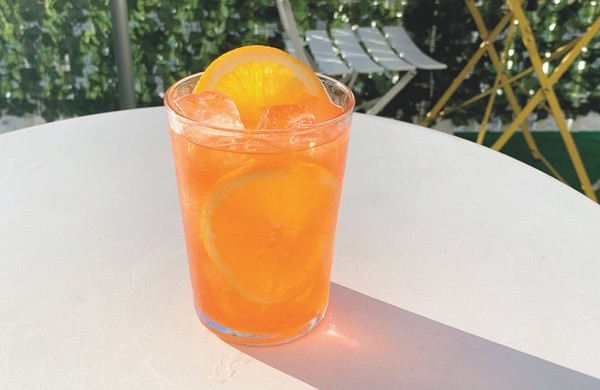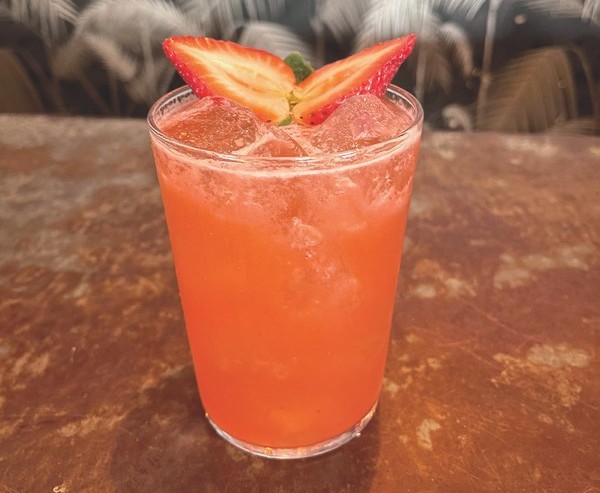
Highball and Spritz-style cocktails are wildly popular right now, which is quite a recent phenomenon. “It was really only a few years ago that the Aperol Spritz and Japanese whisky Highball made it stateside; before then, they were only popular in Italy or Japan, respectively,” says Alexa Delgado, beverage manager at Orlando, Florida’s Lake Nona Wave Hotel, which houses the Living Room Bar. “Not only are these both well-known options now, but bars and restaurants are embracing the wide selection of spirits and mixers available on the market to create new and engaging versions of these cocktails.”
Maxwell Reis, beverage director of the West Hollywood location of Gracias Madre in Los Angeles, also notes the massive popularity of Highballs and Spritzes and how bars have catered to the trend. “The simple build of these types of drinks allows bars to focus on perfecting the pairing of ingredients and showcasing their spirit programs, which is always a win for both the bar and the customer,” he says. “Highballs and Spritzes allow guests to experience a spirit through a very friendly lens, and the spirit is transformed into a refreshing beverage rather than a serious sipper.”
These straightforward combinations are indeed appreciated by consumers and bartenders alike. “They’re easy to drink and also easy to make,” Delgado says. “So whether it’s asking for another round at the bar or pouring yourself another at home, they’re not time-consuming to prepare, so you have more time to enjoy your drink and, hopefully, the company you’re in.”

Approachable Classics
While the Japanese whisky Highball may be a more recent trend in the U.S., the Highball itself—typically one part spirit and three parts mixer—is among the most well-known cocktail builds. “A lot of the cocktails people already know and love fall into this classifica- tion,” Delgado says. “Take for example, a Paloma: by definition, it’s in fact a Highball. Gin & Tonic? Highball. Rum and Coke? Highball.” Delgado enjoys experimenting with the Gin & Tonic in particular. “With the vast variety of gins and different tonics out there, the possibilities for variations are endless and I’ve always had success when it comes to creative G&Ts on a menu,” she says. At the Living Room Bar, her G and Tea ($19) features Nolet’s Silver Dry gin, Lillet Blanc aperitif, 18.21 Earl Grey bitters, and Fever-Tree Lime & Yuzu soda. The Hola Ola Highball ($17), meanwhile, is a simple Tequila Highball of Hornitos Blanco Tequila, house-made soda water, lime juice, and a pinch of Maldon sea salt. P.J. Smerechansky, a Florida-based Highball specialist for Beam Suntory, consulted with the bar team to create the drink. “To make our own soda water we pressurize and carbonate several liters of filtered water, and let it sit overnight in our refrigerator,” Delgado says. “We also chill our Tequila, so when we add it in it binds better with the bubbles, and then we carbonate the whole cocktail in a keg and serve it on draft.”

At Gracias Madre, Reis only works with agave-based spirits and select modifiers, so Tequila-based Highballs are very popu- lar with guests. “But once we gain our guests’ trust, our favorite place to take them is a mezcal Highball,” he says. “Since mezcals are typically higher in alcohol content than most Tequilas, they really benefit from being lengthened and become a lot more approachable for a daunted guest.” His Cupreata Highball ($16) blends La Luna Cupreata mezcal and soda water. “If I’m going for a less spirit-focused Highball, I always love a classic Paloma,” Reis adds. His Paloma ($18) is a force-carbonated combination of Tromba Blanco Tequila, house-made clarified salted grapefruit cordial, Giffard Crème de Pamplemousse Rose pink grapefruit liqueur, and water.
Spritzes have really taken off recently because of the rise of more health-conscious drinkers favoring low-abv cocktails, and it all started with the Aperol Spritz, a mix of two parts Aperol aperitif, three parts sparkling wine (usually Prosecco), and one part soda water. “A lot of people are opting for Spritzes because they typi- cally tend to highlight simple but clean flavors and focus on being low-abv, which means people enjoying them can have a good time for a long time,” Delgado says. “The Aperol Spritz is just the perfect cocktail for daytime sipping or as an aperitif, which is its intended original purpose.”
The Aperol Spritz craze has paved the way for lots of different Spritz variations. At Sweet Liberty in Miami, creative director Naren Young’s Aperol Spritz 2.0 ($17) is served on tap and comprises Aperol, Grey Goose L’Orange vodka, Grand Marnier orange liqueur, orange flower water, saline, and Regans’ No. 6 Orange bitters, topped with Belstar Prosecco and San Pellegrino Aranciata sparkling orange beverage. Meanwhile, at Storico Vino in Atlanta, beverage director Jose Pereiro’s Storico Spritz ($14) features Martini & Rossi Fiero aperitif, Riserva Bitter liqueur, and Martini & Rossi Prosecco, plus sparkling water, while his Passion Spritz ($14) mixes Chinola passion fruit liqueur, house-made cinnamon syrup, lemon juice, Martini & Rossi Prosecco, and sparkling water. And at Chicago’s LondonHouse hotel LH Rooftop bar, the Pamplemousse Spritz ($16) blends Ketel One Botanical Grapefruit & Rose vodka, Giffard Crème de Pamplemousse Rose, and Avissi Prosecco.

More Adventurous Avenues
Delgado notes that one of her favorite signature cocktails at Living Room Bar is her Thomas Edison’s Bright Idea ($16), comprising Lillet Blanc aperitif, Chandon Garden Spritz, and Fever-Tree club soda. “It’s a classic Spritz template, but I use Lillet Blanc, which has wonderful notes of fresh flowers and candied fruits, and I enhance those nuanced flavors with Chandon Garden Spritz, which is a sparkling wine blended with bitters made with Valencia oranges—the bitters in the wine help open your palate and the Lillet is just sweet enough that it makes you want that second glass,” she says. “People are interested in trying variations of their favorite drinks, and now is the time to craft and create those options for them.”
Gracias Madre’s Reis agrees that guests today are more receptive to new spirits and cocktails than ever, and he can usually encourage them to try drinks that might be outside of their usual comfort zone. “For example, many guests will order the classic Aperol Spritz, but we like to take them to more adventurous places that reflect our bar program, so we’ll recommend something like my personal favorite, the Tamarindo Spritz, which includes a modernized Mexican ponche and tepache, a fermented and spiced pineapple rind tea beverage native to Mexico.” The drink ($18) was created by Reis and features Pajarote Ponche de Tamarindo liqueur, Domaine Glinavos sparkling orange wine, house-made tepache, and a splash of soda water.
There’s certainly plenty of room within both the Highball and Spritz templates for bartenders to experiment and get creative. “With so many flavored seltzers and artisanal tonics, the Highball is having a revolutionary facelift,” says LondonHouse food and beverage manager Ashley C. Smith. “Bartenders are having fun with them, playing with seasonal garnish pairings and adding different herbs, fruits, and spices.” At Sorenson’s Café at the Wylder Hope Valley in Hope Valley, California, the Alpenglow ($14) is a creative take on the simple Japanese whisky Highball, blending Suntory Toki whisky, house-made thyme syrup, Fever- Tree tonic water and soda waters, and Peychaud’s bitters. Similarly a twist on the Japanese classic, the Daybreak Highball ($13) by bartender Lauren Steele at the Ramen Shop in Oakland, Califor- nia mixes Baller single malt whisky—St. George Spirits’ version of a Japanese whisky—with Blume Marillen apricot eau de vie and Q club soda.

“More guests know the definition of a Highball today than in previous years, which is probably thanks to Japanese whisky companies marketing Japanese Whisky Highballs,” notes Ryan Fitzgerald, managing partner of ABV restaurant in San Francisco. “And with that expanded knowledge, bartenders are feeling free to push the definition of a Highball to far out places. Almost anything goes at this point, so long as it has something sparkling in it.” There’s a section of ABV’s cocktail menu devoted to Highball builds, many of which feature lesser known or unexpected base spirits, such as bartender Cecily Kllanxhja’s Demonic Tonic ($12), which blends Mas Peyre Le Demon de Midi Rancio Sec solera wine and Fever-Tree tonic, and the Dolomite Highball ($12), which mixes Cappelletti Pasu- bio Vino amaro and Fever-Tree Bitter Lemon tonic water.
“At my bar we try to take simple cocktails to the next level by adding a culinary technique,” Storico Vino’s Pereiro says. “In the case of a Highball, we can make a nice cordial with fruits and some citric acid and add it to our spirit of choice, then use forced carbonation to get a bubbly cocktail.” His Autumn Battle ($14) is a force-carbonated cocktail of Clover gin, St. George Spiced Pear liqueur, Green Chartreuse liqueur, and house-made apple cordial.
Stephen Wicker, bartender at Sweet Liberty, points out that as Spritz and Highball cocktails have gotten more creative, they’re also not necessarily just two or three ingredients anymore. “There are endless combinations to making a long, refreshing drink,” he says. “Most spirits can be used as your base as long as the drink is balanced and bubbly. Citrusy liqueurs can be accentuated extremely well in Spritz cocktails. Also, a little citrus and salinity can be just what your Highball or Spritz needs to take it to another level.” Young’s Strawberries and Company ($15) comprises Lillet Rose aperitif, Milagro Blanco Tequila, Martini & Rossi Riserva Speciale Bitter, strawberry purée, lemon juice, rose water, and saline, topped with Perrier Strawberry carbonated mineral water.
“From the ingredients and vessel to the garnish game, Highball and Spritz cocktails have gotten more inventive, interesting, and incredibly fun,” says Melody Gotauco, head bartender at North Fork Table & Inn in Long Island, New York. “Twists on classics are most bartenders’ go-to, and I love seeing them express themselves.” Her French Apple 75 ($18) is a lighter take on the classic French 75, blending Le Verger French Terroir liqueur, ginger tea, lemon juice, and Tullia Prosecco. “The focus of ingredients has also gotten more in-depth—interesting vermouths or fortified wines make terrific bases for low-abv Spritzes, and using tea in Highballs adds complexity, tannins, and sweetness to the drink,” Gotauco adds. The Homegrown Spritz ($16)—created by Rob Krueger, head bartender for North Fork’s parent company John Fraser Restaurants—features Cocchi Americano aperitif, house-made tart rhubarb syrup, Peychaud’s bitters, and soda water, and his Chamomile Collins ($16) comprises Domaine Dupont Hors D’age Calvados, Bénédictine herbal liqueur, house-made chamomile syrup, lemon juice, and soda water.
“I think Spritzes and Highballs will continue to be on the rise, and just become more innovative,” Gracias Madre’s Reis says, adding that upscale and creative takes on these drinks have helped eliminate the stigma that a Highball is just a dive bar cocktail. “It’s introduced higher end drinkers to the category—at my bar we continue to embrace the trend by utilizing the most modern techniques like carbonating entire cocktails, which I think we’ll see more and more bars embracing.”

